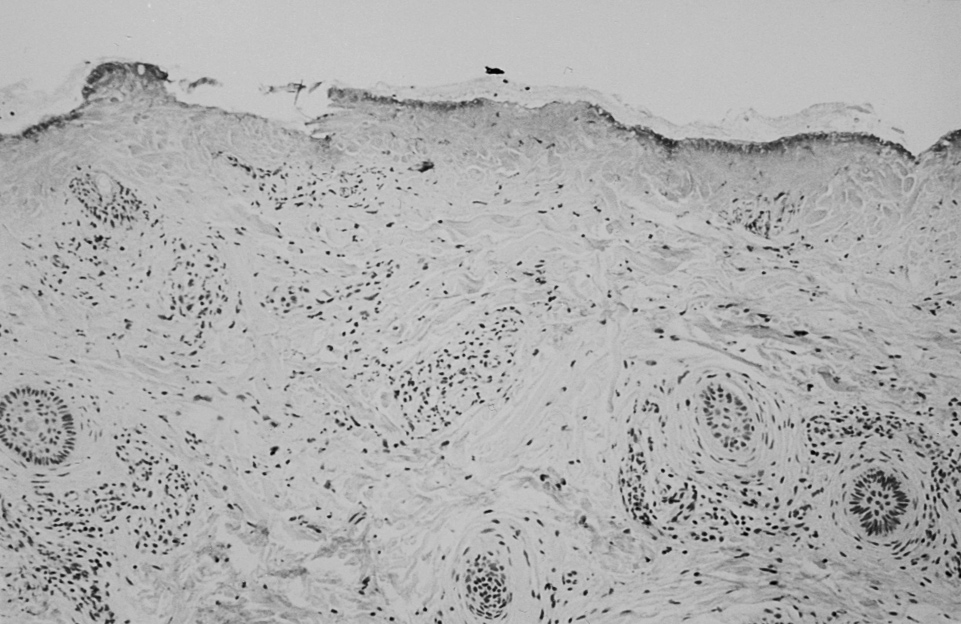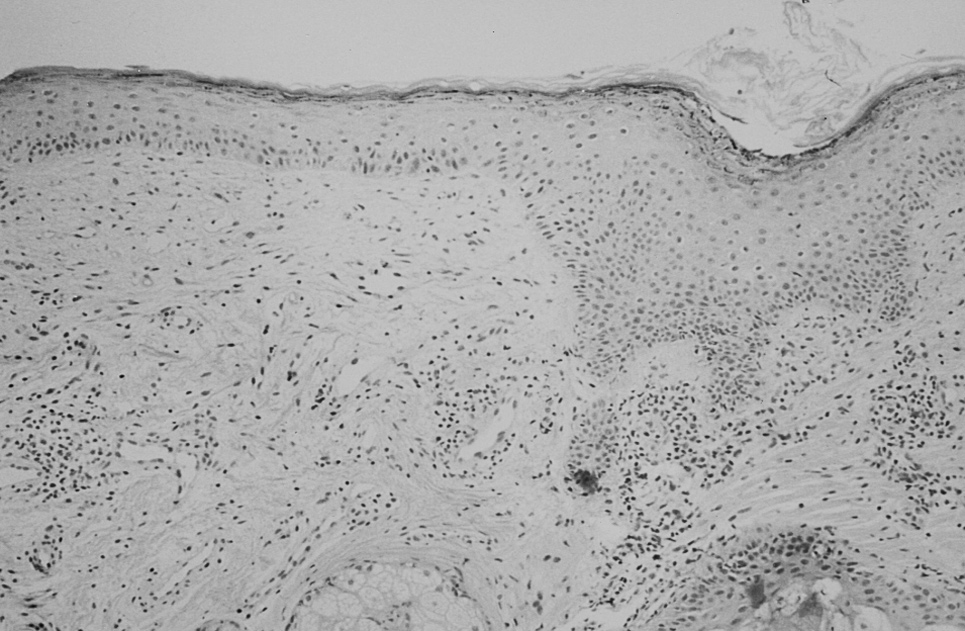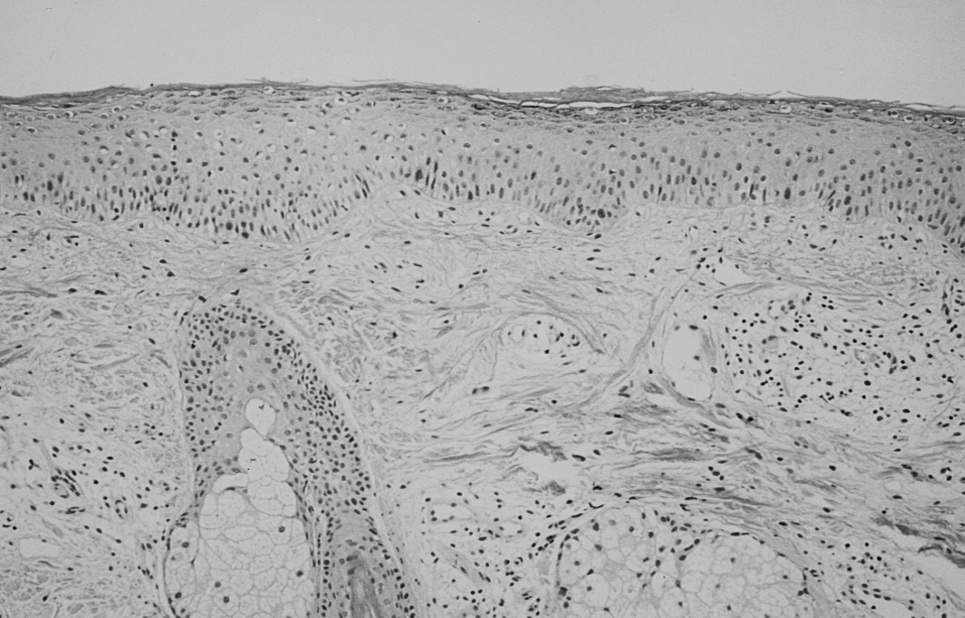Resurfacing of pitted facial acne scars with a long-pulsed er:yag laser
Resurfacing of Pitted Facial Acne Scars with a Long-Pulsed
Er:YAG Laser
Jeung-Tae Jeong, MD and Young-Chul Kye, MD
Department of Dermatology, Korea University Anam Hospital, Seoul, Korea
background.
Conventional short-pulsed Er:YAG lasers show
ately, 1 week, 2 weeks, 4 weeks, and 8 weeks postoperatively
less effective hemostasis and weak photothermal damage on
for histologic examination.
papillary dermis. Recently, newer long-pulsed Er:YAG laser
results.
The results of long-pulsed Er:YAG laser resurfacing
systems has been developed.
for pitted facial acne scars were excellent in 10 patients (36%),
objective.
To evaluate the clinical and histologic effects of
good in 16 patients (57%), and fair in 2 patients (7%). Erythema
long-pulsed Er:YAG laser resurfacing for pitted facial acne
occurred in all patients after laser treatment and lasted longer
than 3 months in 15 patients (54%). Postinflammatory hyperpig-
methods.
Thirty-five patients with pitted facial acne scars
mentation occurred in 8 patients (29%). But the pigmentation
were treated with a long-pulsed Er:YAG laser. All patients had
faded or disappeared within 3 months. One patient (4%) experi-
Fitzpatrick skin phototypes III–V. A pulsed Er:YAG laser with
enced mild hypopigmentation. Pruritic symptoms that required
a 5 mm handpiece at a setting of 7.0–7.5 J/cm2 with a 10-msec
medical intervention occurred in 16 patients (57%). Mild to
pulse duration was used. The laser was fired at 5 Hz, with four
moderate postoperative acne flare-up occurred in 8 patients
to five passes. In 28 patients, the results of laser treatment were
(29%). No other adverse effects such as scarring, bacterial infec-
evaluated for the degree of clinical improvement, duration of
tion, or contact dermatitis were observed.
erythema, pigmentary change, and any adverse events at 2
conclusion.
In conclusion, resurfacing with a long-pulsed Er:
weeks, 1 month, and 3 months. In seven patients, skin biopsy
YAG laser is a safe and very effective treatment modality for
specimens were obtained at the following intervals: immedi-
pitted facial acne scars.
LASER SKIN resurfacing has become a popular treat-
radiation are substantially less than those of CO2, the
ment option for many patients with wrinkles, photo-
rates of intraoperative and postoperative collagen con-
aging, and acne scarring.1 Recently resurfacing with the
traction are attenuated as well.12–14 In order to address
new generation of carbon dioxide (CO2) and Er:YAG
the shortcomings of conventional Er:YAG laser resur-
lasers has come to be preferred for the treatment of fa-
facing, newer Er:YAG laser systems have recently been
cial acne scars.2–7 The Er:YAG laser, with a 2940 nm
developed with longer pulse durations.12 The purpose
wavelength, has high absorption in water, so it is al-
of this study was to evaluate the clinical and histologic
most totally absorbed in a very thin, superficial layer
effects of resurfacing of facial acne scars with a long-
of skin and can be used for precise and superficial tis-
pulsed Er:YAG laser.
sue ablation.6,8,9 The main advantage of the Er:YAGlaser is the precise depth control due to the lack ofthermal injury.6,10,11 Healing is more rapid compared
Materials and Methods
with the CO2 laser. There is less postoperative mor-bidity and fewer complications.6,7 However, because
Thirty-five patients with pitted facial acne scars were in-
of limited residual thermal damage, ranging from 20
cluded in this study. The patients' ages ranged from 19 to 38
to 50 m after a typical resurfacing procedure, intra-
years, with an average age of 26.9 years. In 28 patients (17men, 11 women), clinical improvement and side effects were
operative hemostasis is difficult to achieve. Moreover,
evaluated. In seven patients, skin biopsy specimens were
because the thermal effects of short-pulsed Er:YAG ir-
taken immediately and at 1, 2, 4, and 8 weeks postopera-tively for histologic examination. All patients had Fitz-patrick skin phototypes III–V and underwent a pretreatmentregimen at least 2 weeks prior to laser therapy. The pretreat-
J.-T. Jeong, MD and Y.-C. Kye, MD have indicated no significant in-
terest with commercial supporters.
ment regimen consisted of 0.025% tretinoin cream which
Address correspondence and reprint requests to: Young-Chul Kye, MD,
was applied nightly, broad-spectrum sunscreen, and cetaphil
Department of Dermatology, Korea University Anam Hospital, 126-1,
cleanser. For the anesthesia, topical EMLA cream was used
5-Ka, Anam-dong, Sungbuk-ku, Seoul, 136-705, Korea, or e-mail: jjtderm
1 hour prior to the procedure. To maximize patient comfort
and compliance during the procedure, intravenous fentanyl
2001 by the American Society for Dermatologic Surgery, Inc. • Published by Blackwell Science, Inc.
ISSN: 1076-0512/01/$15.00/0 • Dermatol Surg 2001;27:107–110
jeong et al.: er:yag laser for facial acne scars
Dermatol Surg
Figure 1. (A) Before treatment, and (B) 3
months after laser resurfacing.
100 g was used. All patients were treated with the vari-
75%. And physicians evaluated the side reactions: duration
able-pulsed Er:YAG laser, a 5 mm handpiece at 7.0–7.5 J/cm2
of erythema, pigmentary change, and any adverse events.
with a 10-msec pulse duration. The laser was fired at 5 Hz,with four to five passes. Laser overlapping was less than
10%. Following laser treatment, patients were managed withthe closed technique, using petroleum jelly and gauze. Dress-
The results of long-pulsed Er:YAG laser resurfacing
ings were changed after 48 hours, and when necessary there-
for pitted facial acne scars were excellent in 10 pa-
after. After 7 days the dressings were removed. After laser
tients (36%), good in 16 patients (57%), and fair in 2
treatment, oral prophylaxis consisted of acyclovir 200 mg
patients (7%), a 71% clinical improvement on aver-
five times and tosufloxacin 150 mg three times a day for
age (Table 1, Figure 1).
5 days. Also, to decrease postoperative edema, oral pred-
Thermal damage extended approximately 80–100 m
nisone 10 mg three times a day for 5 days was prescribed.
beneath the vaporized layer and was observed imme-
After 2 weeks of laser treatment, topical application of
diately after laser resurfacing (Figure 2). Two weeks
0.025% tretinoin, 4% hydroquinone, and 1% hydrocorti-
later, complete reepithelialization was observed (Fig-
sone cream were recommended nightly for 4–6 weeks. Broad-
ure 3). A biopsy specimen obtained at 8 weeks showed
spectrum sunscreen and cetaphil cleanser were also recom-
thickening of the epidermis, fine new collagen, and
mended. Facial photographs were taken at baseline and at2-week intervals postoperatively.
high vascularity on the upper dermis (Figure 4).
For clinical assessment, photographs taken at pretreat-
Posttreatment erythema was present in all patients.
ment, 2 weeks, 1 month, and 3 months after laser treatment
In 15 patients (54%), erythema lasted longer than 3
were evaluated by two independent physicians. Physicians
months. Postinflammatory hyperpigmentation occurred
categorized the improvement as follows: poor, improvement
in 8 patients (29%), with a mild degree in 6 patients
less than 25%; fair, improvement of 25–50%; good, im-
and moderate degree in 2 patients. Hyperpigmenta-
provement of 50–75%; excellent, improvement greater than
tion occurred at 2–4 weeks after laser treatment andlasted longer than 3 months in two patients. One pa-tient (4%) experienced mild hypopigmentation, whichbegan around 3 weeks after treatment and lasted longer
Table 1. Degree of Clinical Improvement After Laser Resurfacing
than 3 months after treatment. Mild to moderate post-operative acne flare-up occurred in 8 patients (29%).
Number of patients (%)
Fifteen patients (54%) experienced an itching sensa-
Excellent (ⱖ75%)
tion that required medical intervention. The duration
of itching was 3–21 days (average 8.3 days). No other
adverse effects such as scarring, bacterial infection, or
contact dermatitis were observed (Table 2).



Dermatol Surg
jeong et al.: er:yag laser for facial acne scars
Figure 2. Immediately after laser resurfacing the epidermis was
Figure 4. Eight weeks after laser resurfacing, fine new collagen
completely vaporized. Thermal damage extended approximately
formations and increased vascularity on the upper dermis are ob-
80–100 m beneath the vaporized layer. (Hematoxylin and eosin;
served. (Hematoxylin and eosin; original magnification 100⫻.)
original magnification 100⫻.)
Er:YAG laser resurfacing was better than the results
from conventional short-pulsed Er:YAG laser resur-
The newer variable-pulse Er:YAG lasers have CO
facing reported previously.
The long-pulsed Er:YAG
ser-like effects, while maintaining the advantages of
laser's ability to abrade and its deep photothermal ef-
Er:YAG lasers,15 therefore variable-pulse Er:YAG la-
fects might have contributed to this favorable result.
sers are thought to be effective on pitted acne scars as
Complications such as postinflammatory hyper-
well as rhytides. Also, long-pulsed Er:YAG lasers show
pigmentation, prolonged erythema, itching, and acne
effective hemostasis and some degree of collagen con-
flare-up were observed after long-pulsed Er:YAG laser
traction intraoperatively.12 Thus long-pulsed Er:YAG
treatment. Postinflammatory hyperpigmentation faded
laser resurfacing can offer the surgeon an effective
or disappeared within 3 months after laser treatment.
compromise between CO
To prevent or reduce the postinflammatory hyperpig-
2 and short-pulsed Er:YAG
laser resurfacing systems.12,16 Compared with short-
mentation, proper postlaser treatments such as topical
pulsed Er:YAG lasers, more severe thermal necrosis
tretinoin, hydroquinone, and mild topical steroids in
on papillary dermis was observed on histologic find-
selected patients are thought to be important, espe-
ings.2,10 Complete reepithelialization occurred within
cially in darker skinned patients. Though erythema
2 weeks, as with short-pulsed Er:YAG laser resurfac-
appeared in all patients after laser treatment, the se-
ing. Although our study was not a side-by-side com-
verity of erythema decreased gradually. Prolonged ery-
parison, improvement of acne scars after long-pulsed
thema may be due to deep thermal laser effects andpostoperative use of topical tretinoin. In cases of mildhypopigmentation, long-term follow-up of at least 12–24 months is needed for the evaluation of late hypo-pigmentation. Itching was one of the major problems.
More than half of the patients experienced an itchingsensation that required medical intervention. Fortu-nately these symptoms were treated easily with oralantihistamines. Acne flare-up was also controlled eas-ily by medical intervention. In conclusion, resurfacing
Table 2. Side Effects Following Laser Resurfacing
Side effects
Number of patients (%)
Figure 3. Two weeks after laser resurfacing the epidermis is com-
pletely regenerated and mild inflammatory infiltration and der-
mal edema were observed. (Hematoxylin and eosin; original mag-
nification 100⫻.)
jeong et al.: er:yag laser for facial acne scars
Dermatol Surg
with a long-pulsed Er:YAG laser is a safe and very ef-
the improvement of facial acne scarring: a systemic review of the
fective treatment modality for pitted facial acne scars.
evidence. Br J Dermatol 2000;142:413–23.
8. Kaufmann R, Hibst R. Pulsed Er:YAG and 308 UV excimer laser:
an in vitro and in vivo study of skin ablative effects. Lasers SurgMed 1989;9:132–40.
9. Walsh JT, Deutsch TF. Er:YAG laser ablation of tissue: measure-
ment of ablation rates. Lasers Surg Med 1989;9:327–37.
10. Perez MI, Bank DE, Silvers D. Skin resurfacing of the face with the
1. McDaniel DH, Lord J, Ash K, Newman J. Combined CO2/erbium:
erbium:YAG laser. Dermatol Surg 1998;24:653–9.
YAG laser resurfacing of perioral rhytides and side-by-side com-
11. Alster TS. Clinical and histologic evaluation of six erbium:YAG la-
parison with carbon dioxide laser alone. Dermatol Surg 1999;25:
sers for cutaneous resurfacing. Lasers Surg Med 1999;24:87–92.
12. Alster TS. Cutaneous resurfacing with Er:YAG lasers. Dermatol
2. Kye YC. Resurfacing of pitted facial scars with a pulsed Er:YAG la-
sers. Dermatol Surg 1997;23:880–83.
13. Kaufmann R, Hibst R. Pulsed erbium:YAG laser ablation in cuta-
3. Alster TS, West TB. Resurfacing of atrophic facial acne scars with a
neous surgery. Lasers Surg Med 1996;19:324–30.
high energy, pulsed carbon dioxide laser. Dermatol Surg 1996;22:
14. Weinstein C. Carbon dioxide laser resurfacing: long term follow-up
in 2123 patients. Clin Plast Surg 1998;25:109–30.
4. Fitzpatrick RE, Ratner D, Tse Y, Marchell N, Goldman MP, Fader
15. Zachary CB. Modulating the Er:YAG laser. Lasers Surg Med 2000;
DJ. Cutaneous laser resurfacing. J Am Acad Dermatol 1999;41:
16. McDaniel DH, Newman JB, Lord JL, Ash K. Variable pulse er-
5. Polnikorn N, Goldberg DJ, Suwanchinda A, Ng SW. Erbium:YAG
bium:YAG laser skin resurfacing of perioral rhytides and side-by-
laser resurfacing in Asians. Dermatol Surg 1998;24:1303–7.
side comparison with carbon dioxide laser. Lasers Surg Med 2000;
6. Weinstein C. Computerized scanning erbium:YAG laser for skin re-
surfacing. Dermatol Surg 1998;24:83–9.
17. Brigita D, Vedlin B. Use of Er:YAG laser for benign skin disorders.
7. Jordan R, Cummins C, Burls A. Laser resurfacing of the skin for
Lasers Surg Med 1997;21:13–9.
This study by our colleagues in Korea provides very useful in-
experienced transient postinflammatory hyperpigmentation. These
formation about laser skin resurfacing in Asian skin. The new
clinical findings are consistent with the thermal effects pro-
so-called variable Er:YAG lasers have gained increasing popu-
duced by this mode of the variable Er:YAG laser. However,
larity, especially for treating darker Fitzpatrick skin types. In
there were no significant permanent complications and the
this study one such Er:YAG laser was used in a "thermal"
overall improvement was good. The results in this report of 35
mode (10-msec pulse duration). While not as great as that of
patients should encourage clinicians that, with proper and
the pulsed CO2 laser, this variable-pulse Er:YAG laser produces
skilled use, the new generation of variable-pulse Er:YAG lasers
a distinct thermal effect that is significantly different from the
may help us to provide patients with darker ethnic skin new
shorter pulsed "ablative" mode associated with the "tradi-
therapeutic options for treating pitted acne scars.
tional" use of the erbium resurfacing laser.
About half of the patients in this study experienced 3
David H. McDaniel, MD
months or more of posttreatment erythema and nearly a third
Virginia Beach, Virginia
Source: http://www.jsskin.co.kr/images/dermsurg.pdf
J. K. GIBSON-GRAHAM DEPARTMENT OF HUMAN GEOGRAPHY, THE AUSTRALIAN NATIONAL UNIVERSITY DEPARTMENT OF GEOSCIENCES, UNIVERSITY OF MASSACHUSETTS E L POSESTRUCTURALISMO ES UNA APROXIMACIÓN TEÓRICA AL CONOCIMIENTO Y LA sociedad que acoge la incertidumbre de los significados, el poder cons- titutivo del discurso y la efectividad política de la teoría y la investigación.Las autoras exploran tres conceptos/estrategias posestructuralistas –la de-construcción, la genealogía y la performatividad– resaltando su uso en lageografía económica. El artículo concluye con una exploración acercade la manera como el posestructuralismo transforma y politiza la práctica dela investigación social. Al respecto se consideran tres proyectos de investi-gación posestructuralistas que se involucran en producir o desestabilizarformaciones discursivas, y de esta forma participan en la construcción depoder, subjetividad y posibilidad social.PALABRAS CLAVES: reconstrucción, genealogía, performatividad, investigaciónsocial, investigación-acción.
2015 Comprehensive Formulary HeartlandPlains Health 2015 Formulary List of Covered Drugs PLEASE READ: THIS DOCUMENT CONTAINS INFORMATION ABOUT THE DRUGS WE COVER IN THIS PLAN We have made no changes to this formulary since 10/15/15. For more recent information or other questions, please contact HeartlandPlains Health (HMO) Customer Service, at 1-866-792-0184or, for TTY users, 711, 8:00 am to 8:00 pm, Monday-Friday and 8:00 am to 8:00 pm, Monday-Sunday October 1 through February 14, or visit www.HeartlandPlainsHealth.com.



